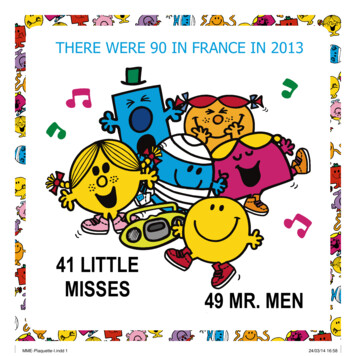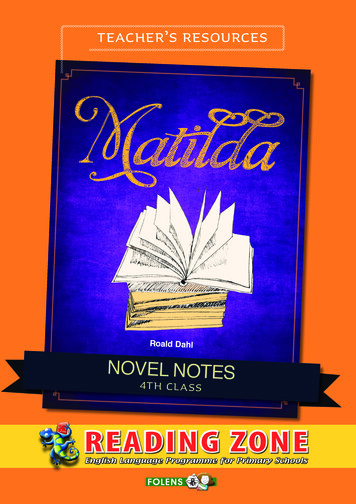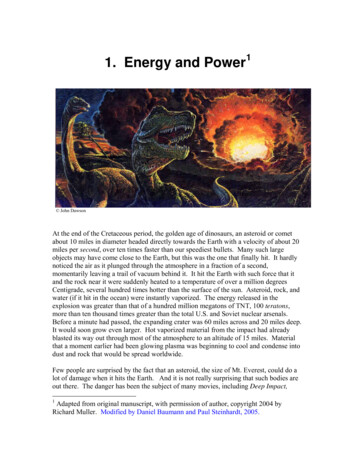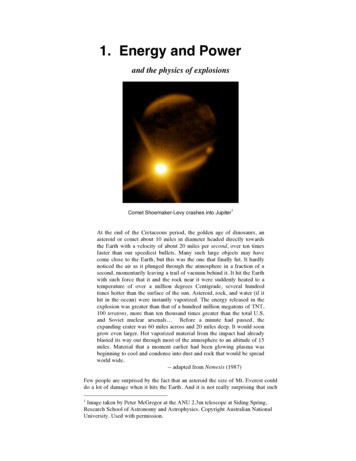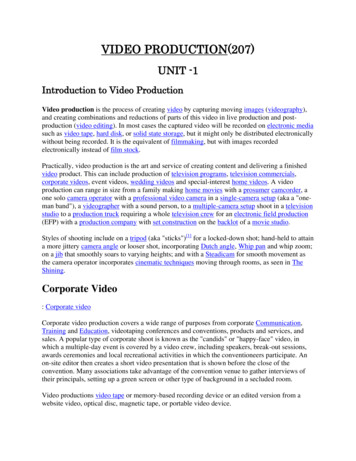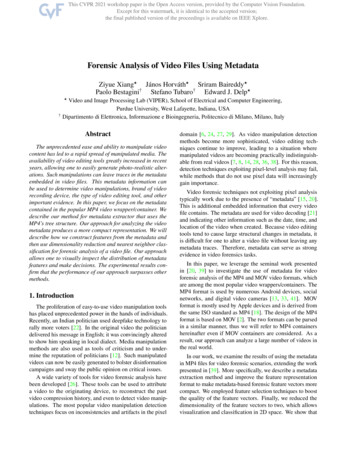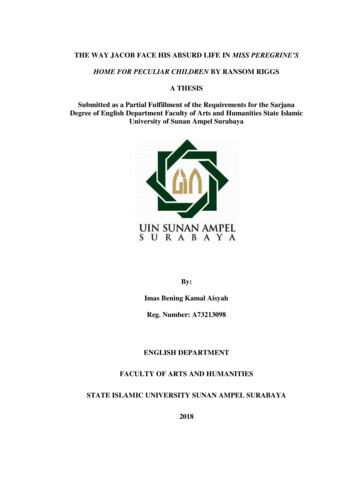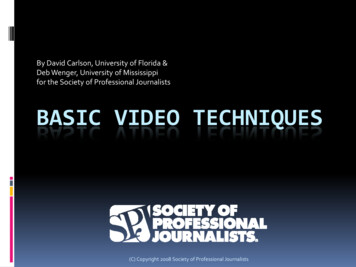
Transcription
By David Carlson, University of Florida &Deb Wenger, University of Mississippifor the Society of Professional JournalistsBASIC VIDEO TECHNIQUES(C) Copyright 2008 Society of Professional Journalists
Video examples Level 1: Video interviews only Level 2: Video interviews supplementalfootage Level 3: Video storytelling
Things to think about Avoid “shaky cam” The best video journalists use a tripodwhenever they can If you can’t use a tripod, steady the cameraagainst a wall Sit on the floor and use your arms and kneesas a makeshift tripod(C) Copyright 2008 Society of Professional Journalists
More things to think about Zooms Don’t do it just because you can Spielberg and Hitchcock both made films withoutzooming one single time Zoom off camera, not on, or Zoom with your feet! NEVER use digital zoom(C) Copyright 2008 Society of Professional Journalists
Shot terminology PANS and TILTS A “pan” is moving the lens side to side A “tilt” is moving the lens up or down Move slowly, even more slowly than yourinstincts tell you to move Know where you’re going before you start(C) Copyright 2008 Society of Professional Journalists
Composition Rememberthe “rule ofthirds”(C) Copyright 2008 Society of Professional Journalists
Headroom Give ‘em some space-- in the right place Make sure people’s heads are not cut off But don’t make shots too loose either When you must cut a body, cut it in logical places,such as joints – the knees, not the ankles Apply the rule of thirds – one third of the frameabove the eyes, one third below the neck(C) Copyright 2008 Society of Professional Journalists
Backgrounds Force yourself to look at the background ofyour shot Avoid unintentional motion or distraction No trees or posts coming out of your subject’s head(C) Copyright 2008 Society of Professional Journalists
Shots you need “B-ROLL” B-roll is secondary footage that can flesh outthe story and add visual interest Make sure you allow time to shoot B-roll andtry to think in advance of shots to get Shoot more than you think you’ll need!(C) Copyright 2008 Society of Professional Journalists
You be the expert! OK -- we’ve learned the basics. Now be a critic. Watch this story and see how manyproblems you can spot.
You be the judge (C) Copyright 2008 Society of Professional Journalists
Shots you need Three types of shots are needed for virtuallyany story: The “establishing shot” (usually wide angle) A picture of the whole soccer field The “medium shot” focusing in on the action Kids playing soccer on that field The “close-up” A sweaty face, an anxious mom(C) Copyright 2008 Society of Professional Journalists
Shot ratio What’s your guess on the ratio of shots? What’s the average percentage of close ups,medium and wide shots? Think about the makeup of a story this way: 50 percent close ups and extreme close ups 25 percent medium shots 25 percent wide shots(C) Copyright 2008 Society of Professional Journalists
Shots you need Don’t shoot it all from eye level Use different points of view Move around Have an “angle” Get down on your knees – or your stomach Climb up on something Lie on your back(C) Copyright 2008 Society of Professional Journalists
Stick with it Stay on the shot Every shot should be at least 5 seconds long. Stay with the shot 5 seconds longer than you thinkyou should Count it down because 5 seconds is longer thanyou think Video editors will thank you(C) Copyright 2008 Society of Professional Journalists
Shot sequences Think action / reaction If the soccer ball is kicked(the action), your viewer willwant to see it go in the net(the reaction) Think sequences Of shots Of events(C) Copyright 2008 Society of Professional Journalists
Brainstorming the story Video assignment:Gas prices boost use ofcommuter buses What shots will you get? Let’s watch!
Lighting Good lightingreally does matter Don’t shoot at noon Try to arrange your shoot for morning or lateafternoon If you can’t, try to shoot in “full shade” Keep camera and subject in same lightingconditions(C) Copyright 2008 Society of Professional Journalists
Lighting If it’s dark, add light Open the curtains or blinds Turn on lamps and lights Move subject to a better location,if possible DIY lighting kits can be inexpensive(C) Copyright 2008 Society of Professional Journalists
Get the sound Pros will tell you the sound is at leastas important as the pictures Without an external microphone, youneed to get close! Be aware of background noise A busy street will drown out voices Move your interview subject for bettersound(C) Copyright 2008 Society of Professional Journalists
Shooting an interview Do shoot thesubject straighton, or slightlyangled --not inprofile Don’t have thesubject lookinto the camera(C) Copyright 2008 Society of Professional Journalists
Shooting an interview Frame up theface andshoulders Be aware ofthe directionof the light Rule of thirds(C) Copyright 2008 Society of Professional Journalists
Interview questions Avoid two-partquestions Ask open-endedquestions – thosethat evokeemotion, feelingor opinion(C) Copyright 2008 Society of Professional Journalists
Shooting an interview The hardest part? Keeping yourmouth shut!(C) Copyright 2008 Society of Professional Journalists
Let’s shoot! Teams of two Each person is to operate camera,interviewing each other about your favoriteplace on the Ole Miss Campus Go to that spot and shoot 2 video sequences Bonus points if you find someone there totalk to! Be back on time – you have 45 minutes(C) Copyright 2008 Society of Professional Journalists
Let’s watch! What’s one thing you feel your team did verywell? What’s one thing you know you could dobetter next time? Instructor’s choice
Seven deadly sins1. Headhunting--placing every subject in thecenter of your frame.2. Motor zooming--overuse of on-screenzooms.3. Rooting--staying in one spot instead oflooking for interesting angles.(C) Copyright 2008 Society of Professional Journalists
Seven deadly sins4. Fire hosing--panning all over the scene.5. Upstanding--shooting everything fromstanding eye-level.6. Snap shooting--taping only two or threeseconds per shot.7. Backlighting--too much light falling on thebackground instead of on the subject.(C) Copyright 2008 Society of Professional Journalists
What we learned Stabilize your shots/tripod Frame for head & nose room Shoot sequences & hold your shots Be aware of the lighting Sound really, really matters YOU can do it!(C) Copyright 2008 Society of Professional Journalists
By David Carlson, University of Florida &Deb Wenger, Virginia Commonwealth Universityfor the Society of Professional JournalistsBASIC VIDEO TECHNIQUES(C) Copyright 2008 Society of Professional Journalists
YouTube link(C) Copyright 2008 Society of Professional Journalists
You be the expert! OK -- we’ve learned the basics. Now be a critic.
